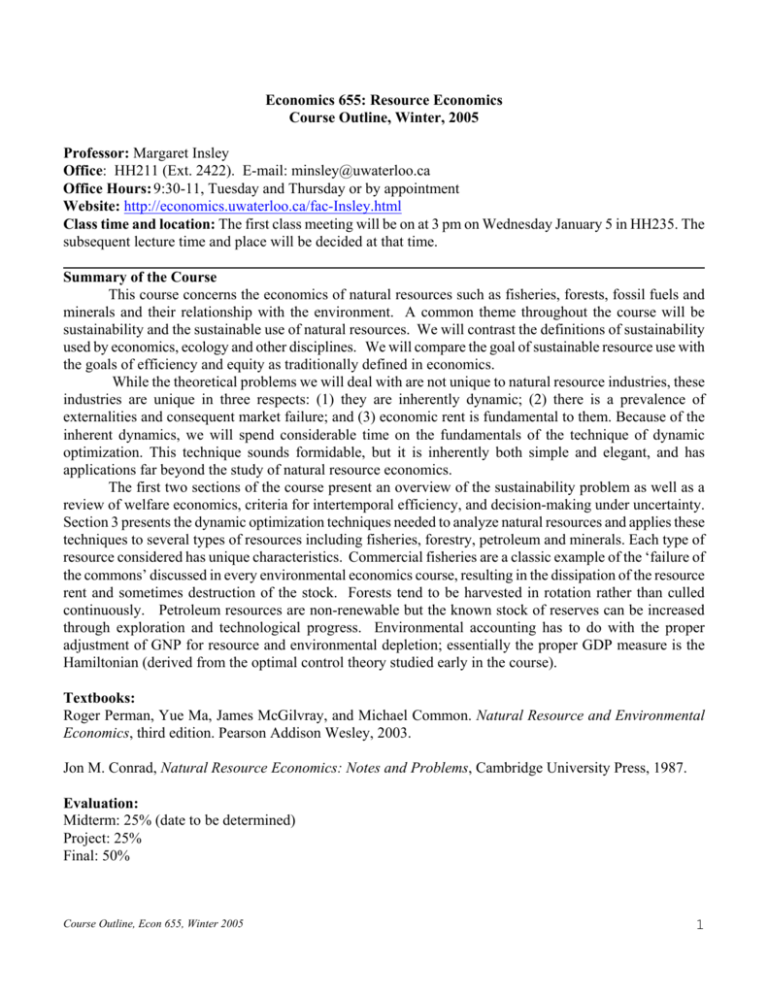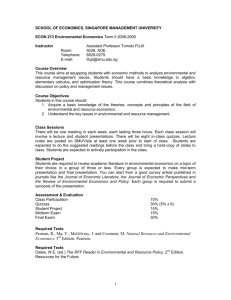
Economics 655: Resource Economics
Course Outline, Winter, 2005
Professor: Margaret Insley
Office: HH211 (Ext. 2422). E-mail: minsley@uwaterloo.ca
Office Hours: 9:30-11, Tuesday and Thursday or by appointment
Website: http://economics.uwaterloo.ca/fac-Insley.html
Class time and location: The first class meeting will be on at 3 pm on Wednesday January 5 in HH235. The
subsequent lecture time and place will be decided at that time.
Summary of the Course
This course concerns the economics of natural resources such as fisheries, forests, fossil fuels and
minerals and their relationship with the environment. A common theme throughout the course will be
sustainability and the sustainable use of natural resources. We will contrast the definitions of sustainability
used by economics, ecology and other disciplines. We will compare the goal of sustainable resource use with
the goals of efficiency and equity as traditionally defined in economics.
While the theoretical problems we will deal with are not unique to natural resource industries, these
industries are unique in three respects: (1) they are inherently dynamic; (2) there is a prevalence of
externalities and consequent market failure; and (3) economic rent is fundamental to them. Because of the
inherent dynamics, we will spend considerable time on the fundamentals of the technique of dynamic
optimization. This technique sounds formidable, but it is inherently both simple and elegant, and has
applications far beyond the study of natural resource economics.
The first two sections of the course present an overview of the sustainability problem as well as a
review of welfare economics, criteria for intertemporal efficiency, and decision-making under uncertainty.
Section 3 presents the dynamic optimization techniques needed to analyze natural resources and applies these
techniques to several types of resources including fisheries, forestry, petroleum and minerals. Each type of
resource considered has unique characteristics. Commercial fisheries are a classic example of the ‘failure of
the commons’ discussed in every environmental economics course, resulting in the dissipation of the resource
rent and sometimes destruction of the stock. Forests tend to be harvested in rotation rather than culled
continuously. Petroleum resources are non-renewable but the known stock of reserves can be increased
through exploration and technological progress. Environmental accounting has to do with the proper
adjustment of GNP for resource and environmental depletion; essentially the proper GDP measure is the
Hamiltonian (derived from the optimal control theory studied early in the course).
Textbooks:
Roger Perman, Yue Ma, James McGilvray, and Michael Common. Natural Resource and Environmental
Economics, third edition. Pearson Addison Wesley, 2003.
Jon M. Conrad, Natural Resource Economics: Notes and Problems, Cambridge University Press, 1987.
Evaluation:
Midterm: 25% (date to be determined)
Project: 25%
Final: 50%
Course Outline, Econ 655, Winter 2005
1
Project Details:
The project will consist of a written review (about 15 pages in length) of one or two journal articles and
an in-class presentation. Students may choose their paper(s) from a bibliography that will be handed out
early in the semester. The written review and presentation will identify the problem being examined,
clearly describe the model and discuss its results in the context of course material and relevant literature.
The oral presentation will be scheduled sometime in February or March. The written review is due on
April 5.
Tentative list of topics and readings
This list of topics may be adjusted throughout the term based on time and interest. The reading list will be
added to throughout the term.
1. Introduction
• Perman, Chapter 2
• Environment and Development Economics, Oct 1998, Vol 3, Number 4, p. 491-537, contains
several articles which revisit the Limits to Growth Debate
2. Foundations
2.1 Ethical viewpoint in resource and environmental economics
• Perman, Chapter 3
2.2 The economics approach to sustainability: weak versus strong sustainability
• Perman, Chapter 4
2.3 Welfare economics and the environment
• Perman, Chapter 5
2.4 Intertemporal Efficiency
• Perman, Chapter 11
2.5 Irreversibility, risk and uncertainty
• Perman, Ch 13
3. Natural Resource Exploitation
3.1 The efficient and optimal use of natural resources
• Perman, Ch 14
• Conrad (if it arrives in the bookstore in time)
• References for dynamic optimization include Chiang, Kamien and Schwartz, and Leonard and
Long.
3.2 Nonrenewable resources
• Perman, Ch 15
• Conrad
3.3 Stock pollution problems
• Perman, Ch 16
3.4 Fisheries economics
• Perman, Ch 17
• Conrad
3.5 Forest economics
• Perman, Ch 18
3.6 Environmental accounting
• Perman, Ch 19
Course Outline, Econ 655, Winter 2005
2
General Reference Books on Reserve in the Porter Library
Chiang, A. C. (1992). Elements of Dynamic Optimization New York, McGraw Hill. HB143.7 C45.
Clark, C.W. (1976). Mathematical Bioeconomics. New York, Wiley. QH705.C4
Conrad, J. M. and C. W. Clark (1987). Natural Resource Economics: Notes and Problems. Cambridge,
Cambridge University Press. HC59 C693
Hartwick, J. M. and N. Olewiler (1986). The Economics of Natural Resource Use. New York, Harper and
Row. HC59 H3558 (on reserve for Econ 355)
Kamien, M. J. and N. L. Schwartz (1981). Dynamic Optimization: Calculus of Variations and Optimal
Control in Economics and Management. New York, North Holland. QA402.5 K32
Course Outline, Econ 655, Winter 2005
3







